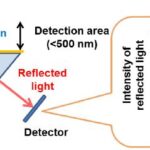Surface plasmon resonance (SPR) is a biotechnology that uses biosensing chips to analyze the interaction relationships between molecules.
SPR can be used in life science fields such as proteomics, cell signaling, receptor-ligand, antibody-antigen molecule draping, immune recognition, cancer research and new drug screening for real-time and dynamic study of biomolecular interaction processes such as protein-protein, protein-nucleic acid, and new drug molecule-target protein.
The principle of SPR technology
With the help of traditional optical phenomena, SPR uses light to generate evocative waves in different media to generate resonance with plasma waves, and then constructs biomolecular interaction to detect the interaction between ligand and analyte on the biosensor chip.
The light source of the SPR biosensor is polarized light. The surface of the sensing chip is coated with a gold film. For the experiment, a biomolecule (target molecule) is first immobilized on the surface of the gold film. Then the molecule with which it interacts is dissolved in a solution (or mixture) and flowed across the chip surface. The resonance angle changes as the protein on the gold film chip and the molecule in the flow path bind and have dissociation. The detector detects this change, according to this change curve for graphical analysis. The intermolecular binding constant Ka, dissociation constant Kd or affinity constant KD can be derived.
learn more: dynamic light scattering

Principle of SPR sensor (Yanase et al., 2014)
Advantages of SPR technology
The advantages of the surface plasmon resonance sensing technique include no labeling; high sensitivity; fast, accurate, efficient and targeted detection of the corresponding results; and low injection volume requirements.
How is SPR measured?
A typical SPR assay includes five steps: (1) sample and buffer preparation; (2) ligand immobilization on chip surface; (3) analyte measurement; (4) surface regeneration, and (5) data analysis.

Application of SPR

Applications of surface plasmon resonance sensors (Rifat et al., 2019)
1. Drug development
Screening of drugs is one of the essential parts of conducting drug research.SPR is widely used for drug screening due to its rapid selection of fragments with binding affinity. It provides kinetic data on biomolecular interactions, enabling researchers to quantify the binding properties of lead compounds to their targets in terms of affinity, specificity and binding/dissociation rates in parallel.
Quantitative kinetics of compound binding can be used to better understand the binding mechanisms and processes, as well as the effects induced by changes in chemical structure. Screening and selection of developed drugs can be used to more efficiently find the most effective drug for a disease, identify the most suitable drug with the appropriate active ingredient, and increase the speed and efficiency of new drug innovation.
2. Biological drug quality control
1) Evaluation of immunogenicity
Biological drugs are immunogenic, and when repeatedly administered several times, antibodies are produced in animals and even in humans. This may be caused by differences in structure or properties between recombinant and natural proteins. Anti-drug antibodies can form complexes with the drug, which can neutralize the drug activity or interfere with the normal metabolism of the drug. Therefore, immunogenicity is one of the important indicators to evaluate the safety of biological drugs. The SPR technique is sensitive and can be used to detect the immunogenicity of antibodies at low concentrations.
2) Determination of binding activity
In the quality standards of most biological drugs, activity assay is an important indicator to evaluate the potency of the active ingredient of the drug. Activity assay is generally divided into binding activity assay and biological activity assay. The former is to evaluate the ability of the drug to bind to the target receptor, while the latter evaluates the ability of the drug to induce relevant immunological responses after binding to the target. SPR technology is faster and more efficient than ELISA, and is currently used to examine the binding activity of therapeutic monoclonal antibody products.
3) Detection of residual host cell DNA
The residual DNA of passaged cell lines is tumorigenic and virulently infectious. The relevant metabolic pathways and mechanisms are unknown and pose a certain threat to human health, so quality control of residual DNA in host cells is needed. Currently, q-PCR technology is commonly used, but PCR technology has time-consuming, easy to contaminate and other detection problems. Some studies have shown that SPR technology can be used for DNA detection.
4) Control of microbial contamination
The vast majority of biological drugs are intravenous or subcutaneously injected products, which require strict control of microbial contamination, otherwise it will bring great safety risks to patients. Currently, culture methods are commonly used to identify and control bacteria and other microorganisms. However, this method has disadvantages such as time-consuming and easy contamination. SPR technology allows for faster detection of microorganisms.
3. Food safety
Detection of toxic residues in food is an important task in the field of food safety. Currently SPR technology can detect pesticides, herbicides, biotoxins and environmental contaminants in food.
References
- Yanase, Y., Hiragun, T., et al. (2014). Surface plasmon resonance for cell-based clinical diagnosis. Sensors, 14(3), 4948-4959.
- Rifat, A. A., Hasan, R., Ahmed, R., & Miroshnichenko, A. E. (2019). Microstructured optical fiber-based plasmonic sensors. In Computational Photonic Sensors (pp. 203-232). Springer, Cham.

